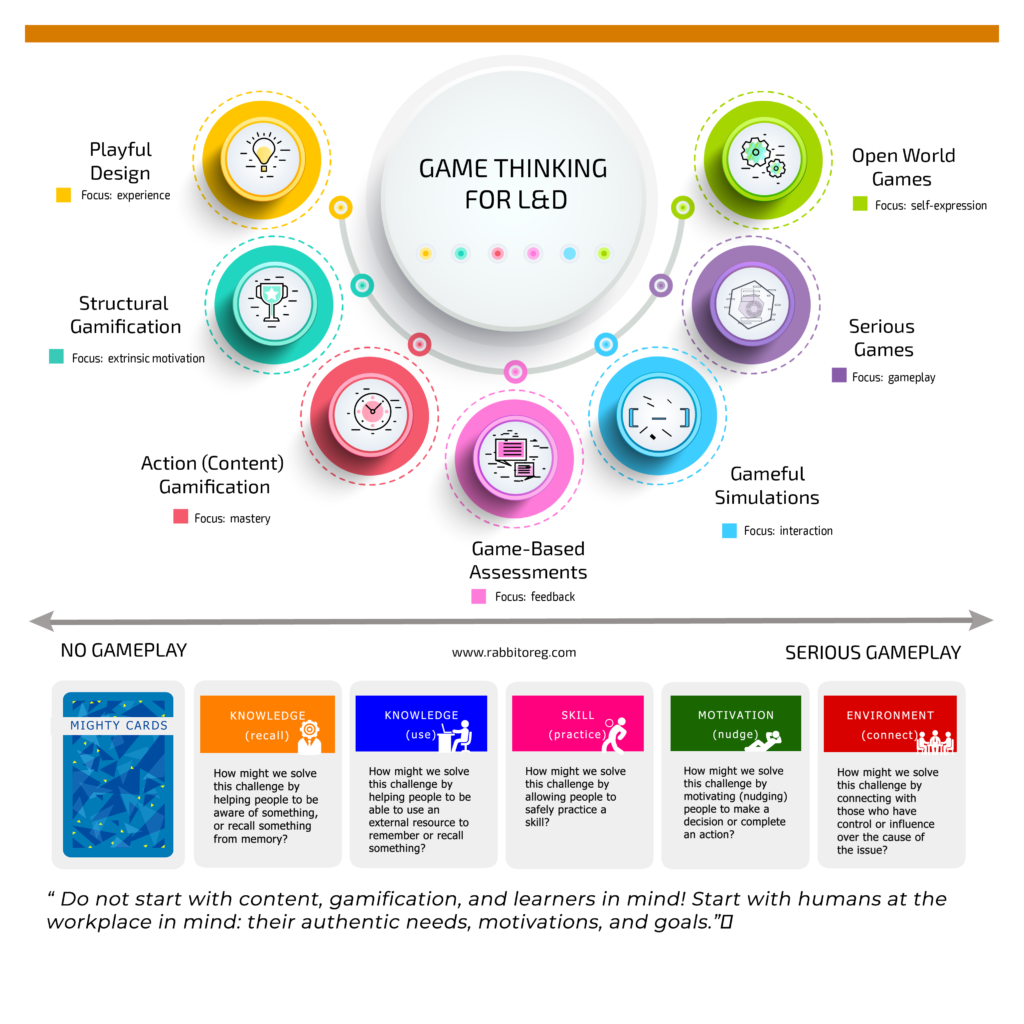Timers in Game Thinking for L&D with Zsolt Olah | Episode 077
Listen to this episode on your phone!
Zsolt Olah is a creative learning consultant at Kineo with over 15 years of L&D experience. Zsolt is a frequent speaker at learning conferences on the subject of engagement and game thinking for L&D. He was in the top 50 authors of the year on elearningindustry.com for two consecutive years, and he’s also published a gameful book, called Engage the WORL&D!: A whimsical, brain-picking “meme-oir” from a creative digital learning strategist. With a degree in information technology, Zsolt’s been not only talking the game but walking the game with various workshops using game engines and sharing his prototypes online. When he used to have free time he wrote a feature film screenplay that was a finalist in an international competition.
His day starts early with his teenage twins followed by the commute to his basement, where he works from home for Kineo. He uses the camera to connect with clients all over the world. Projects generally focus on learning, performance and goals for business. He likes to call it digital problem-solving!
Zsolt’s fail story is all about timers. In his experience, it is necessary to have a lot of bad ideas to come up with the good ones! This story is focused on using the timer as an engagement strategy, in a game themed on races. After this experience he realized that timers can be a terrible cause of anxiety, he realized it’s also important to look at the surroundings of players to see if something like a timer makes sense for them. If they are regularly under time constraints, go ahead timers will be fine, if not, perhaps it is not the best idea. There are also other approaches to timers, which can be used as boosters and not as a formal restriction. We also ran into a follow-up of the application of time restrictions in tests for students. I found his perspective on this to be quite interesting! He even mentioned that he realized that in the workplace, the use of timers makes many employees feel as though someone is watching them, even though it is not the case and this can generate a quite negative level of anxiety.
A success story with time constraints is actually of a time when he needed to set up a call center with experienced agents that, however, had no experience with the new product (wireless). This had to happen in just a month. The training originally would be an 80-page pdf to read. What he created was a trivia to measure some of the knowledge, and then the groups would challenge other groups creating their own trivia! It involved a lot of teamwork, analysis of the text itself and then taking the questions of the other teams. They also collected all this information and delivered it to the face-to-face instructor who would deliver some of the training that is hands-on, so that person could actually focus on the areas that it was more necessary!
Zsolt doesn’t start with gamification or game thinking. For him, it all starts with Cathy Moore‘s strategy of Action Mapping. This is before the content or design, it is about thinking about the problem, the goals, the actions and decisions that the potential learners need to make along with the barriers they have to achieve the goals. It is about finding if the problem is having more knowledge, skills, motivation or if it has nothing to do with training but rather with perhaps the technology they’re using for their daily work. With this in mind, the design then comes in and it could be gamification, game thinking or something different.
A best practice would certainly be problem-solving, as a segway to the previous topic. It is all about tailoring solutions for your real audience, which can often times be quite diverse. For example, one problem with leaderboards is when they are applied to groups that include non-competitive individuals. For example, Andrzej Marczewski’s User Types could be a framework for thinking about this. His favorite game, well actually games are Civilization, for boardgames Settlers of Catan, for digital games Minecraft and in terms of digital storytelling, it would be Firewatch.
Zsolt would love to listen to Karl Kapp (perhaps once again!), Sharon Boller and once again to Amy Jo Kim! With books he would go to the same sources, so he would recommend Karl Kapp and Sharon Boller’s Play to Learn: Everything You Need to Know About Designing Effective Learning Games and Amy Jo Kim’s Game Thinking: Innovate smarter & drive deep engagement with design techniques from hit games. Then his superpower would be to start with action mapping and real people and then to use gamification and game thinking if it makes sense!
The random question is all about getting started in gamification. For more click play and listen to the episode!
His final advice would be to think of gamification as another tool in your toolkit. Especially don’t just start with gamification but with what is the problem to be solved, the motivations and the goals!
We can find Zsolt on Twitter as @rabbitoreg and on LinkedIn as Zsolt Olah. His webpage is rabbitoreg.com. Of course, you can also work with Zsolt through Kineo!
There are many ways to get in touch with Professor Game, you can go to my Twitter @RobAlvarezB, my Instagram, our Facebook Page, subscribe to our email list and even ask a question to future guests!
Looking forward to reading or hearing from you,
Rob




Hi, my name is Zsolt and I’m not a Pokémon. – Rabbitoreg (Zsolt Olah)
May 26, 2019 @ 4:28 pm
[…] The last five years I’ve been speaking at national and international conferences about games and gamification. I’ve had numerous conversations with L&D professionals about why it’s not a good idea to start with games and gamification for a course. That’s not the same as “don’t use games or gamification!” It means you do not start with them. If you’re thinking of using games and gamification to “engage learners,” read this article first about engagement for humans. Here’s my recorded webinar with Training Magazine and a podcast interview with Professor Game. […]